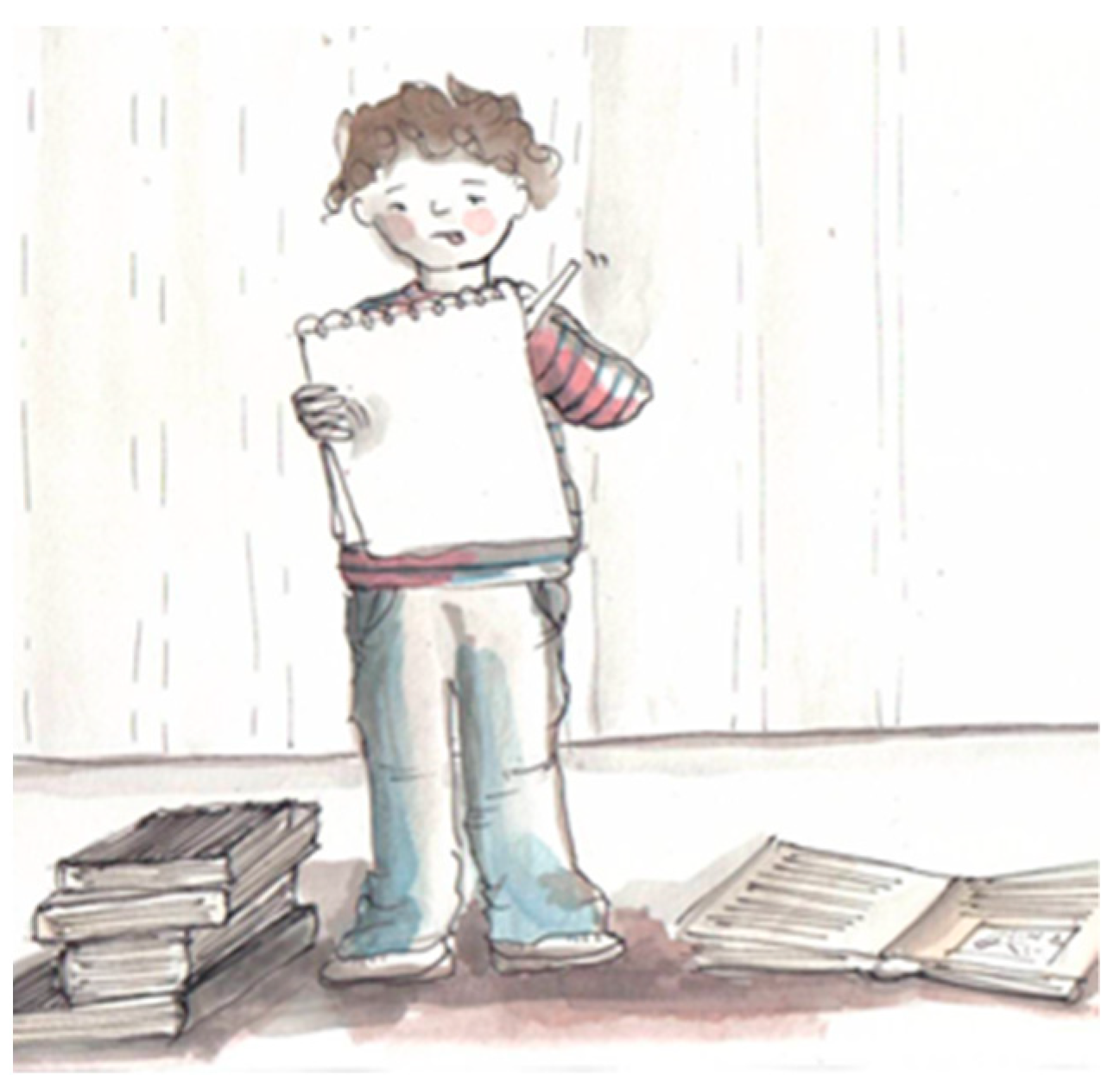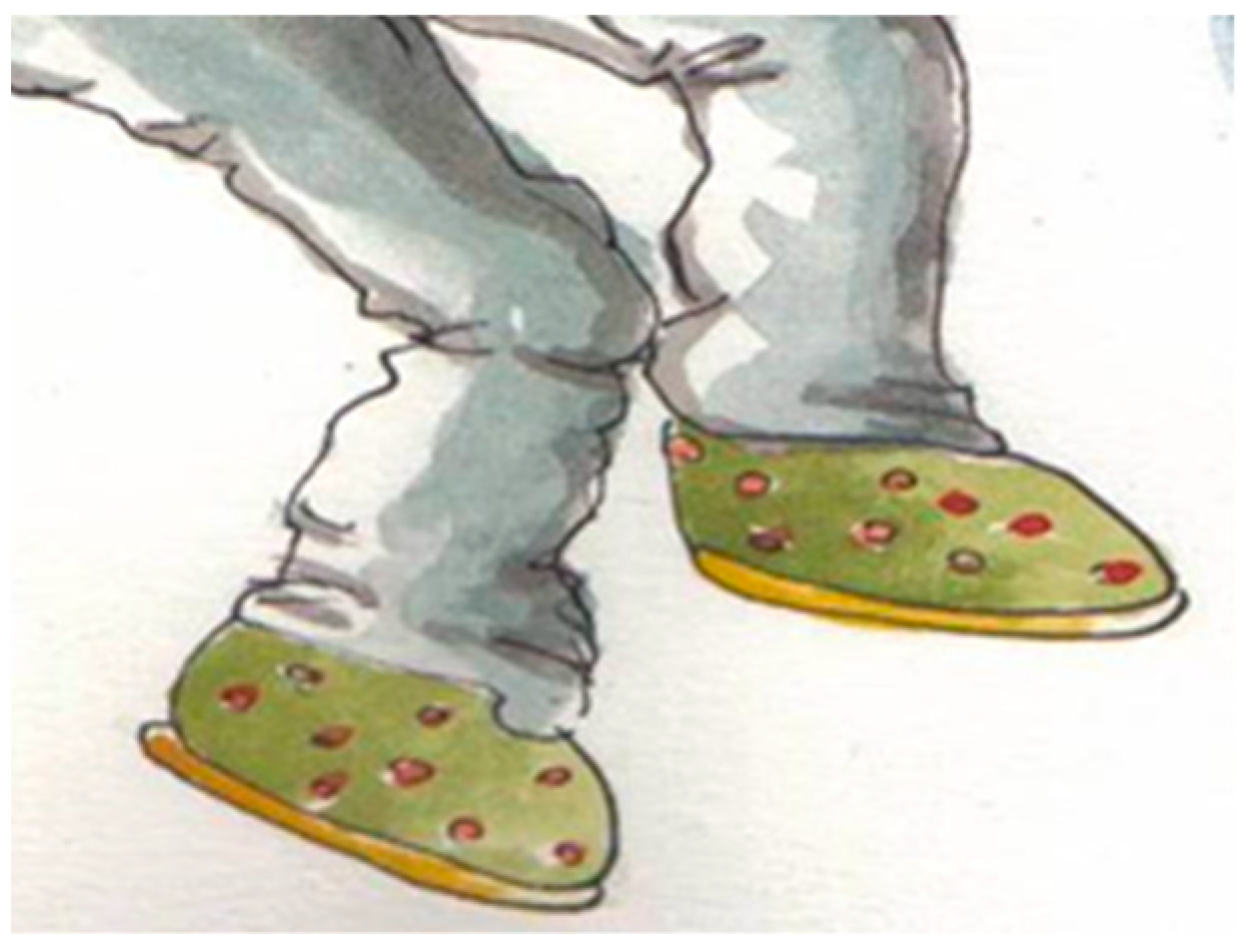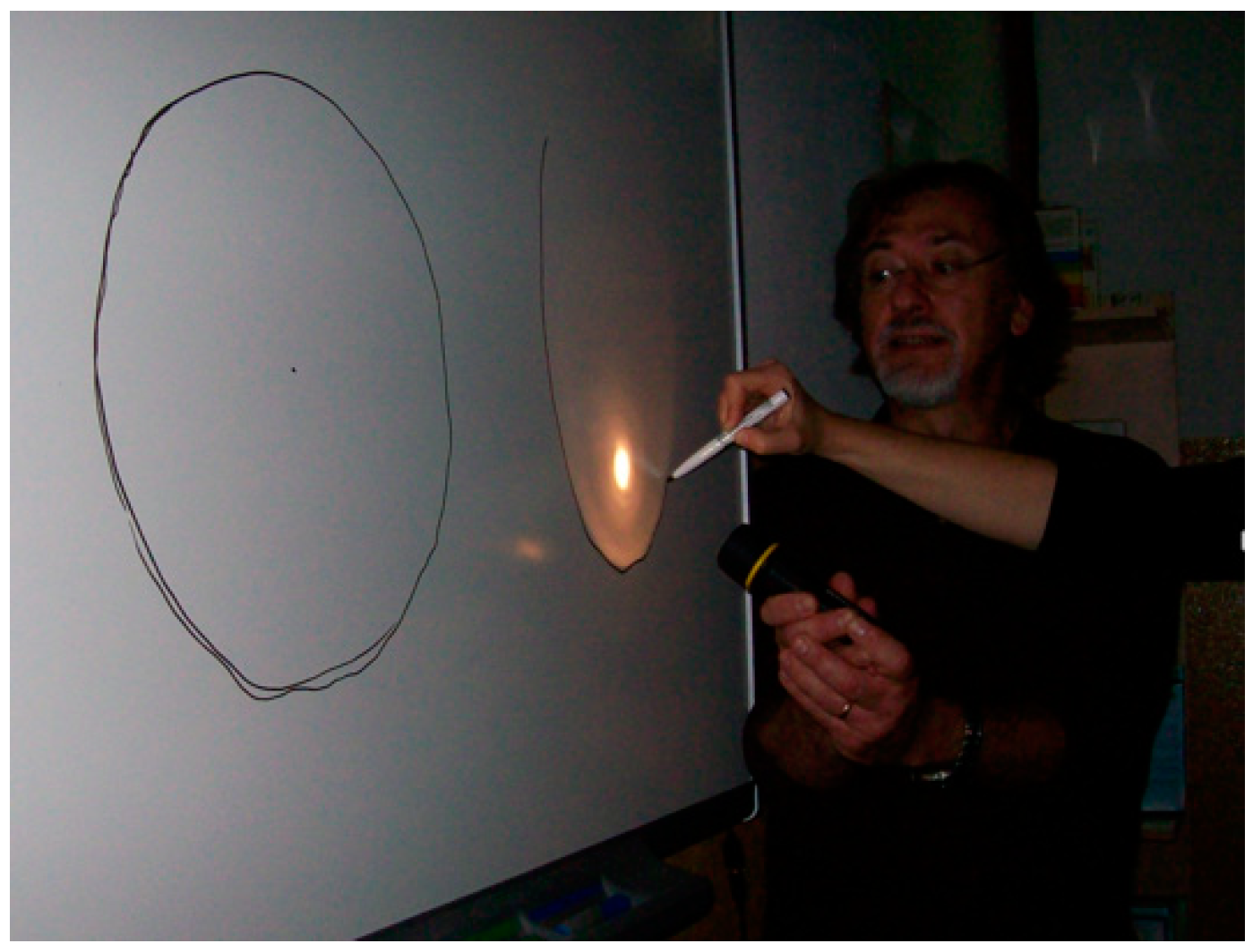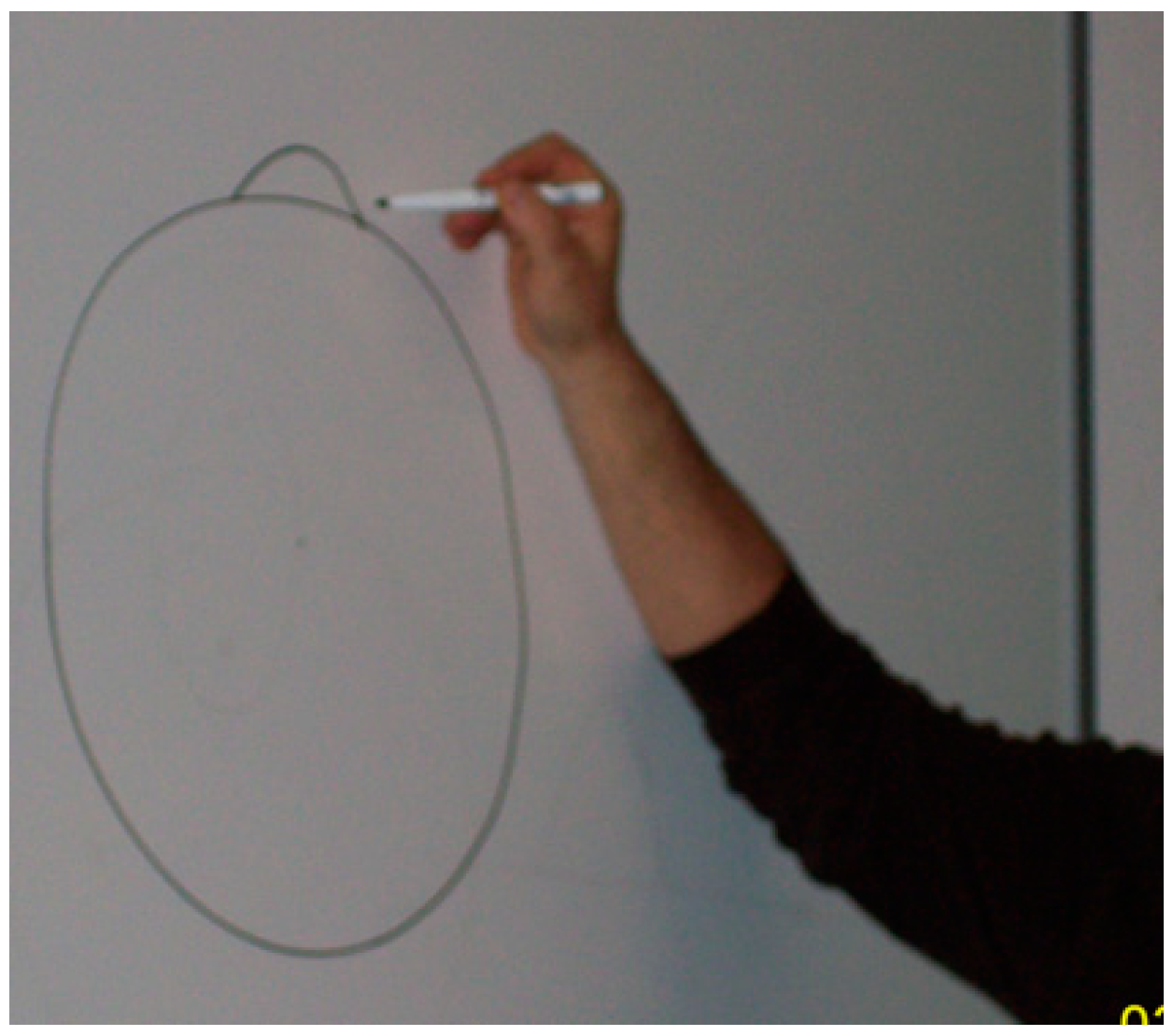Stories and Theatre for Teaching Physics at Primary School
Abstract
:1. Introduction
2. Mommy Comet—A Story for Primary School
2.1. Materials and Methods
“Claudio is a child like many others, perhaps a little chubby, maybe every now and then his tongue stumbles and words do not come out as easily as he would like. Claudio perhaps blushes when in class the teacher asks him to read. Oh, yes. But this afternoon Claudio is also worried more than usual about the upcoming sport competition that will be held the next day at school. [...]
Claudio is going to spend the whole afternoon studying...(Figure 3)
But how?! I mean: would it not be better if he exercised a little bit in jumping? But he is studying. He is browsing without stopping his books, trying to understand what animals are able to do long jumps. After studying, he also begins to work in order to turn a pair of sneakers in a couple of kalofrogillo.(Figure 4)
That’s how Claudio named his invention, which contains the secrets of the jumps of kangaroo, locust, frog and nine-banded armadillo.
[...] “Let Claudio prepare for the first jump!” [...] Claudio’s heart beats so hard that it seems to jump out of his chest; excited and upside down, he does not remember kalofrogillo anymore and gets ready on the starting line, takes a running start, lifts off the ground and (Figure 5.)... pof! While Claudio was jumping, his back was designing a curve in the air, but from the point of departure to the arrival point, only... One meter twenty… short!”.
2.2. Results
3. Under Another Light—A Scientific Theatre Play for Children
3.1. Materials and Methods
- Conduct a 45-minute interview with 54 primary school classes, 26 of whom attended the show in the same year of the research, 13 in the previous year and 18 (control group) did not see the show at all;
- Catalogue nearly 500 drawings, randomly chosen among the thousands sent to us by children;
- Analyze the questionnaires given to the teachers.
3.2. Result
- Have the contents presented during the show clear connections with the didactic program carried out in the class? No 2%, Yes 98%;
- If your previous answer is yes, do you think the show was a useful teaching aid? No 0%, Somewhat 10%, A lot 90%;
- In the first week following the show, how many children spontaneously talked about the show? Nearly all: 43%, more than a half 13%, 5 to 10: 21%, 3 to 5: 6%; 1 to 2: 17%.
4. Discussion
5. Conclusions
Funding
Institutional Review Board Statement
Informed Consent Statement
Data Availability Statement
Acknowledgments
Conflicts of Interest
References
- Bonura, A. Percezione e rappresentazione: Un percorso didattico tra geometria, Fisica e Arte. Giornale di Fisica 2008, 255–279. [Google Scholar]
- Carpineti, M.; Cavinato, M.; Giliberti, M.; Ludwig, N.; Perini, L. Theatre to motivate the study of physics. JCOM 2011, 10, 1–10. [Google Scholar] [CrossRef] [Green Version]
- Giliberti, M. La Percezione della Fisica negli Studenti di Scuola Secondaria di secondo grado: Indagine Statistica collegata allo Spettacolo Teatrale TRACCE. In Proceedings of the Frascati Physics Series—Italian Collection, Collana: Scienza Aperta, II—ComunicareFisica2010, Proceedings 3° Convegno “Comunicare Fisica e altre Scienze”, Frascati, Italy, 12–16 April 2010. [Google Scholar]
- Tolstrup Holmegaard, H.; Møller Madsen, L.; Ulriksen, L. To Choose or Not to Choose Science: Constructions of desirable identities among young people considering a STEM higher education programme. Int. J. Sci. Ed. 2014, 36, 2. [Google Scholar]
- Shulman, L.S. Those Who Understand: Knowledge Growth in Teaching. Educ. Res. 1986, 15, 4–14. [Google Scholar] [CrossRef]
- Bernardini, C.; Tarsitani, C.; Vicentini, M. (Eds.) See, for Instance, the Whole Volume Thinking Physics for Teaching; Plenum Press: New York, NY, USA, 1995; ISBN 0-360-45192-1. [Google Scholar]
- Guidoni, P. Presentazione in Approcci e Proposte per L’insegnamento-Apprendimento Della Fisica a Livello Preuniversitario; Guidoni, P., Levrini, O., Eds.; FORUM Editrice Scolastica Udinese: Udine, Italy, 2008; p. 7. [Google Scholar]
- Giliberti, M. Fisica a teatro (Lo scrigno di Prometeo); Aracne: Aricia, Italy, 2014; ISBN 8854877069. [Google Scholar]
- Cavallini, G.; Giliberti, M. La lezione della fisica quantistica. Epistemologia 2008, 31, 219–239. [Google Scholar]
- From the Discussion in the Conference “.Convegno “Quale Didattica Della Fisica per Formare Gli Insegnanti di Scuola Primaria?” Piano Nazionale Lauree Scientifiche Fisica (unict.it). 2021. Available online: http://www.laureescientifichefisica.unict.it/content/scienze-formazione-primaria (accessed on 21 September 2021).
- Homer. The Odyssey with an English Translation by A.T. Murray, PH.D; William Heinemann, Ltd.: London, UK; Harvard University Press: Cambridge, MA, USA, 1919; Volume 2, Available online: http://www.perseus.tufts.edu/hopper/text?doc=Perseus%3Atext%3A1999.01.0136%3Abook%3D9 (accessed on 22 August 2021).
- Ogborn, J. Science and Commonsense, Connecting Research in Physics Education with Teacher Education; Vicentini, M., Sassi, E., Eds.; Gautam Rachmandani: New Dehli, India, 2008; p. 7. Available online: https://web.phys.ksu.edu/icpe/publications/teach2/Ogborn.pdf (accessed on 21 September 2021).
- Abrahamson, C.E. Storytelling as a pedagogical tool in higher education. Acad. J. Artic. Educ. 1998, 118, 3. [Google Scholar]
- Corni, F.; Fuchs, H.D. Primary Physical Science for Students Teachers at Kindergarten and Primary School Levels Part I—Foundations of an Imaginative Approach to Physical Science. Interchange 2020, 51, 315–343. [Google Scholar] [CrossRef] [Green Version]
- Fuchs, H.U. Force Dynamic Gestalt, Methaphor and Scientific Thought; University of Applied Sciences et Winterthur: Zurich, Switzerland, 2010. [Google Scholar]
- Carpineti, M.; Cavallini, G.; Giliberti, M.; Ludwig, N.; Mazza, C.; Perini, L. Let’s throw light on matter: A physics show for primary school. IL Nuovo Cimento Della Società Italiana di Fisica. B, General Physics, Relativity, Astronomy and Mathematical Physics And Methods 2006, 121, 901–911. [Google Scholar] [CrossRef]
- Ødegaard, M. Dramatic science. A critical review of drama in science education. Stud. Sci. Educ. 2003, 39, 75–101. [Google Scholar] [CrossRef]
- Fazio, C.; Carpineti, M.; Faletič, S.; Giliberti, M.; Jones, G.; Mcloughlin, E.; Planinšič, G.; Battaglia, O.R. Strategies for Active Learning to Improve Student Learning and Attitudes Towards Physics. In Teaching-Learning Contemporary Physics: From Research to Practice; Jarosievitz, B., Sükösd, C., Eds.; Springer: Berlin/Heidelberg, Germany, 2021; pp. 213–233. ISBN 978-3-030-78719-6. [Google Scholar]
- TEMI (Teaching Enquiry with Mysteries Incorporated). European Community’s Seventh Framework Programme (FP7/2007-2013) under grant agreement n° 321403—2012-1. Available online: https://cordis.europa.eu/project/id/321403 (accessed on 21 September 2021).
- Barbieri, S.; Giliberti, M. Three Stories, Three Toolkits: Magnetize Attention, Light up Coloured Ideas, Gas Fantasy into Science. In Concepts, Strategies and Models to Enhance Physics Teaching and Learning; McLoughlin, E., van Kampen, P., Eds.; Springer: Cham, Switzerland, 25 July 2019. [Google Scholar] [CrossRef]
- Barbieri, S.; Giliberti, M. Mommy, comet short stories for introductory mechanics. Problemy Wczesnej Edukacji 2011, 3, 133–136. [Google Scholar]
- Available online: http://spettacolo.fisica.unimi.it (accessed on 22 August 2021).
- McGregor, D. Chronicling innovative learning in primary classrooms: Conceptualizing theatrical pedagogies to successfully engage young children learning science. Pedagog. Int. J. 2014, 9, 216–232. [Google Scholar] [CrossRef]










| Q1-Q1 | Both right | Wrong | Cartoon-like | Displacement | Only one way motion (non back and forth) | |
| 1st gr. | 27 | 3 | 2 | 8 | 8 | |
| 5th gr. | 32 | 1 | 3 | 3 | 7 | |
| Q3 | Right | Wrong | Ambigous | Impossible | No drawings | No explanations |
| 1st gr. | 9 | 15 | 1 | 6 | 7 | 5 |
| 5th gr. | 27 | 9 | 3 | 0 | 0 | 0 |
| Q4 | Right | Wrong | Ambigous | Impossible | No drawings | |
| 1st gr. | 32 | 4 | 0 | 0 | 2 | |
| 5th gr. | 27 | 6 | 4 | 0 | 1 | |
| Q5 | (a) (correct) | (b) | (c) | (d) | ||
| 1st gr. | 3 | 22 | 4 | 4 | ||
| 5th gr. | 20 | 13 | 3 | 1 | ||
Publisher’s Note: MDPI stays neutral with regard to jurisdictional claims in published maps and institutional affiliations. |
© 2021 by the author. Licensee MDPI, Basel, Switzerland. This article is an open access article distributed under the terms and conditions of the Creative Commons Attribution (CC BY) license (https://creativecommons.org/licenses/by/4.0/).
Share and Cite
Giliberti, M. Stories and Theatre for Teaching Physics at Primary School. Educ. Sci. 2021, 11, 696. https://doi.org/10.3390/educsci11110696
Giliberti M. Stories and Theatre for Teaching Physics at Primary School. Education Sciences. 2021; 11(11):696. https://doi.org/10.3390/educsci11110696
Chicago/Turabian StyleGiliberti, Marco. 2021. "Stories and Theatre for Teaching Physics at Primary School" Education Sciences 11, no. 11: 696. https://doi.org/10.3390/educsci11110696
APA StyleGiliberti, M. (2021). Stories and Theatre for Teaching Physics at Primary School. Education Sciences, 11(11), 696. https://doi.org/10.3390/educsci11110696






